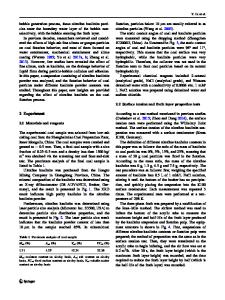The sintering behavior of ultrafine alumina particles
- PDF / 3,383,011 Bytes
- 12 Pages / 576 x 792 pts Page_size
- 16 Downloads / 346 Views
Ultrafine particles (UFPs) of aluminum oxide were prepared by an arc discharge, sintered in a custom-built ultrahigh vacuum (UHV) furnace system, and characterized in a high resolution electron microscope (HREM) operating under UHV conditions. The UFPs produced range in size from 20 to 50 nm and have highly faceted surfaces. The atomic structure of the UFPs corresponds to the cubic (7) and orthorhombic (6) variants of the spinel structure. Sintering in these UFPs demonstrates three major issues. Surface faceting plays a major role in determining the final sintering geometry with sintering occurring predominantly on the close-packed {111} facets. Surface diffusion is the predominant mechanism for sintering, as evidenced by the fact that many sintered particles have their initial adhesion structure 'locked-in' during sintering with no reorientation occurring. Furthermore, the necks formed during sintering have well-defined, atomically sharp contact angles which suggests that the neck growth process is controlled by the faceted structures and may be modeled by a mechanism similar to crystal growth due to ledges, grain boundaries, and twins. The driving force for sintering can be considered as a chemical potential difference between facet surfaces and the neck region.
I. INTRODUCTION Ceramics are materials of extreme technological importance, prized for their chemical resistivity, hardness and wear resistance, high melting temperature, and low densities. And yet, the widespread application of these materials has been impeded by their sensitivity to mechanical and thermal shocks as a result of their brittle nature. The relatively poor mechanical properties are usually considered to be the consequence of flaws within the materials which lead to catastrophic failure. Whereas metals may plastically deform, either by the motion of lattice dislocations1 or diffusional creep,2 materials with immobile lattice dislocations are brittle at low temperatures where diffusional creep is inoperative. In recent developments,3 ceramic materials have been tailored to accommodate diffusional creep at low temperatures. This is achieved by making the grain size of the polycrystalline ceramic on the order of a few nanometers (nm), hence the name nanocrystalline materials. Nanocrystalline materials may deform plastically under an applied stress due to the ease with which the small grains slide past each other. Another way to view the behavior of nanocrystalline materials is through an analogy to the Hall-Petch 4 ' 5 relationship in metals which states that the yield stress is related to the grain size as:
a = a0 +
(1)
"'Present address: Hitachi Advanced Research Laboratory, Hatoyama, Saitama 350-03, Japan. J. Mater. Res., Vol. 7, No. 6, Jun 1992
http://journals.cambridge.org
Downloaded: 22 Nov 2014
where a is the yield stress, a0 the lattice friction stress required to move individual dislocations, / a constant, and d the spatial grain size. According to this relationship, a material with grain size of a few nms should possess improved
Data Loading...











